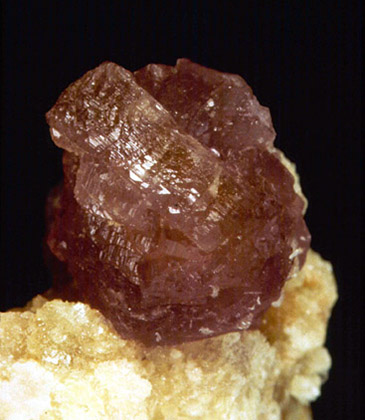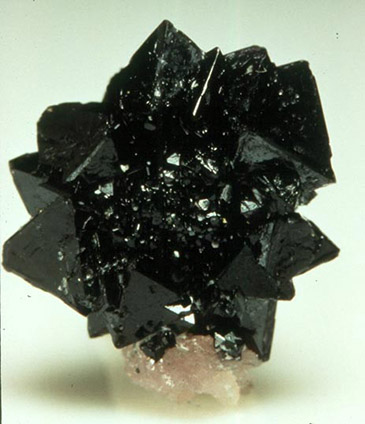Iron Mountain
Sulfate Minerals at Iron Mountain

Coquimbite from the Richmond mine, Iron Mountain, CA.G. Robinson.

Voltaite from the Richmond mine, Iron Mountain, CA.
Width of specimen is 8 mm.G. Robinson.
The underground workings within the Richmond mine at Iron Mountain are host to a spectacular array of sulfate minerals, which form from the evaporation of metal-rich, highly acidic mine water. These minerals are known as efflorescent, or flowering salts.
Most of the sulfate minerals within the Richmond mine are iron-bearing. The relatively simple salts are composed exclusively of ferrous iron (Fe(II)) such as melanterite, FeSO4·7H2O. Others contain only ferric iron (Fe(III)), such as coquimbite, Fe2(SO4)3·9H2O.
Some of the more complex iron-sulfate minerals at Iron Mountain contain both ferrous and ferric iron, such as voltaite, K2Fe5IIFe 4III(SO4)12·18H2O, and römerite, FeIIFe2III(SO4)4·14H2O.
The USGS has participated in several detailed studies involving sulfate minerals from Iron Mountain. In collaboration with Prof. Heather Jamieson, Prof. Ron Peterson, and graduate student Claire Robinson (Queen's Univ., Kingston, Ontario, Canada), the geochemistry of copiapite-group and jarosite-group minerals were studied (Jamieson and others, 2005a, 2005b). Melanterite-group minerals were characterized by Alpers and others (1994). The composition and spectroscopic properties (vibrational, x-ray absorption, and Mössbauer spectra) of several sulfate minerals from Iron Mountain were characterized by Mazjlan and others (2011). Raman spectra for several sulfate minerals were characterized by Sobron and Alpers (2013).
The spectral data from sulfate salts collected at Iron Mountain have been used as standards for several investigations including sulfates on other planetary bodies including Mars (e.g. Alpers and others, 2008; Bishop and others, 2008; Sobron and Alpers, 2013).
Stakeholders


News
July 26, 2018
Public lecture: Iron Mountain, California: An Extreme Acid Mine Drainage Environment, presented by Charles Alpers, USGS Research Chemist
Saturday, May 13, 2013 at 3:30pm PST
TEDx UC Davis talk on "The Search for Evidence of Past Microbial Life on Mars" by Ph.D. candidate Amy Williams. A video of the presentation is now available online.
Publications
- Sobron, Pablo and Alpers, Charles (2013)
- Raman Spectroscopy of Efflorescent Sulfate Salts from Iron Mountain Mine Superfund Site, California, Astrobiology, v.13, p.270-278.
Additional Mars Research
Amy Williams
Ph.D. Candidate
University of California, Davis
Professor Dawn Sumner
Mars Science Laboratory
NASA Mars Science Laboratory - Curiosity Rover
Related Resources
USGS National Research Program: Chemical Modeling of Acid Waters, Iron Mountain, Shasta County, CA
U.S. Environmental Protection Agency: Pacific Southwest Superfund, Iron Mountain Mine

Contacts
Project Chief: Charles Alpers
Phone: 916.278.3134
Email: cnalpers@usgs.gov
